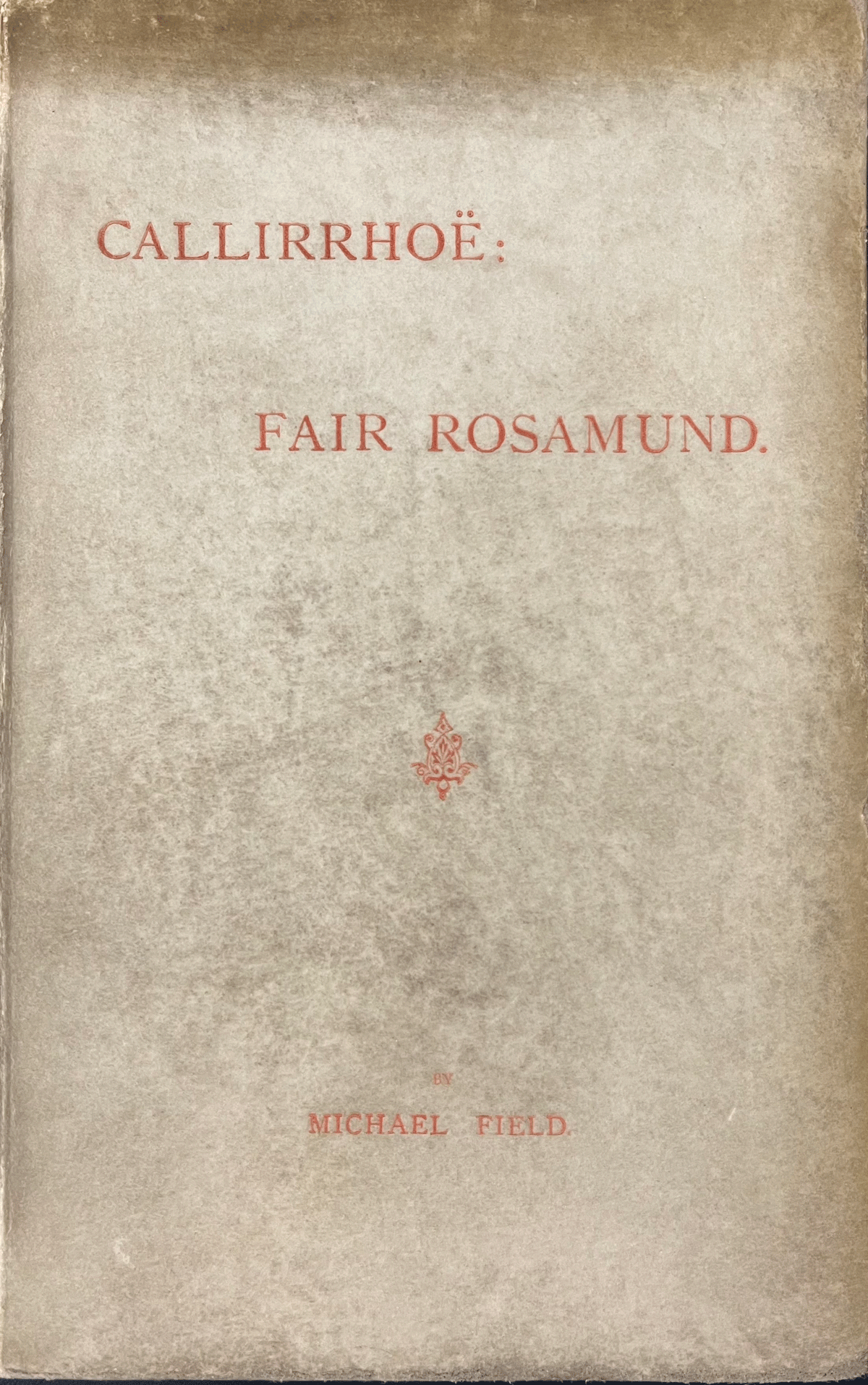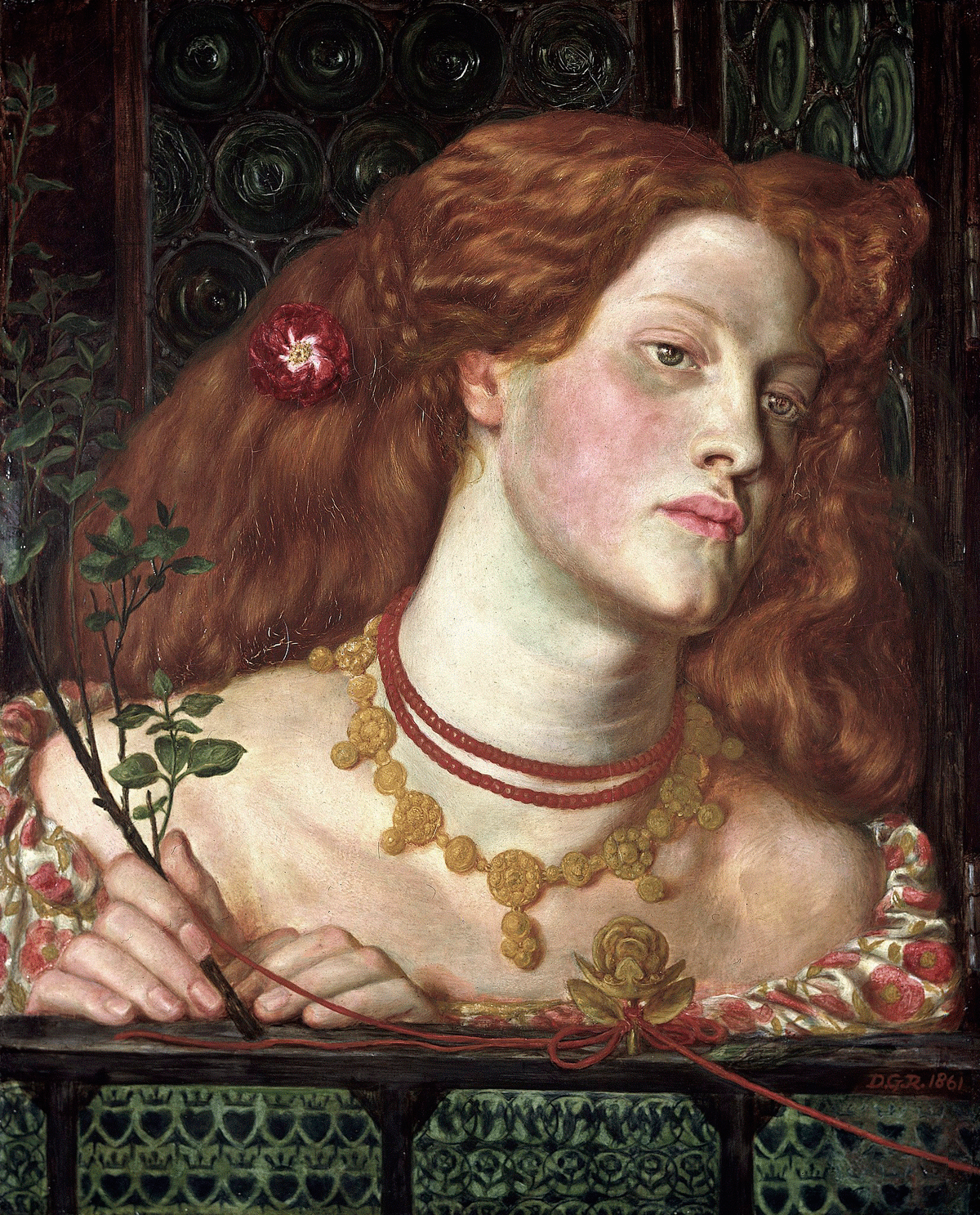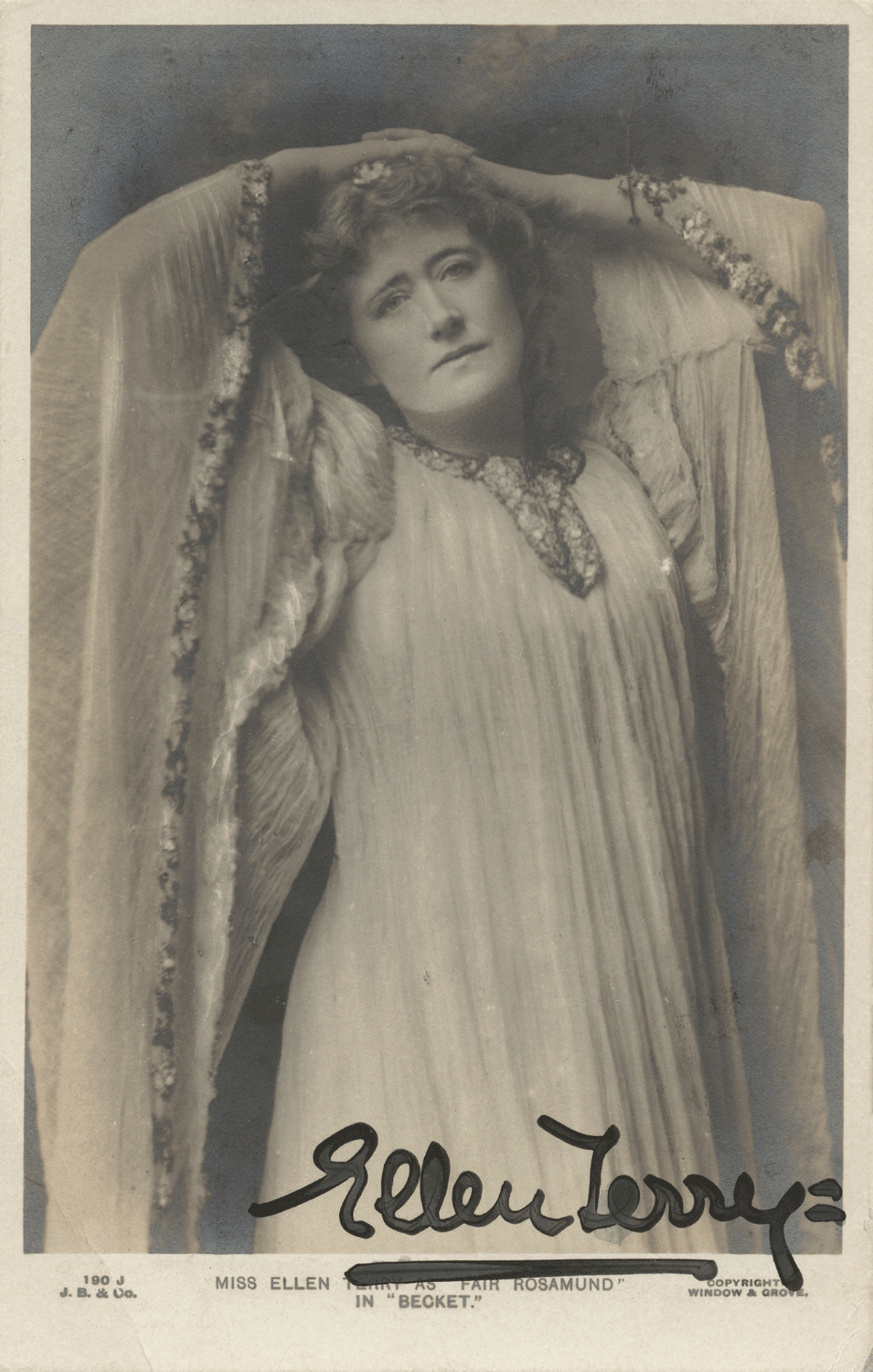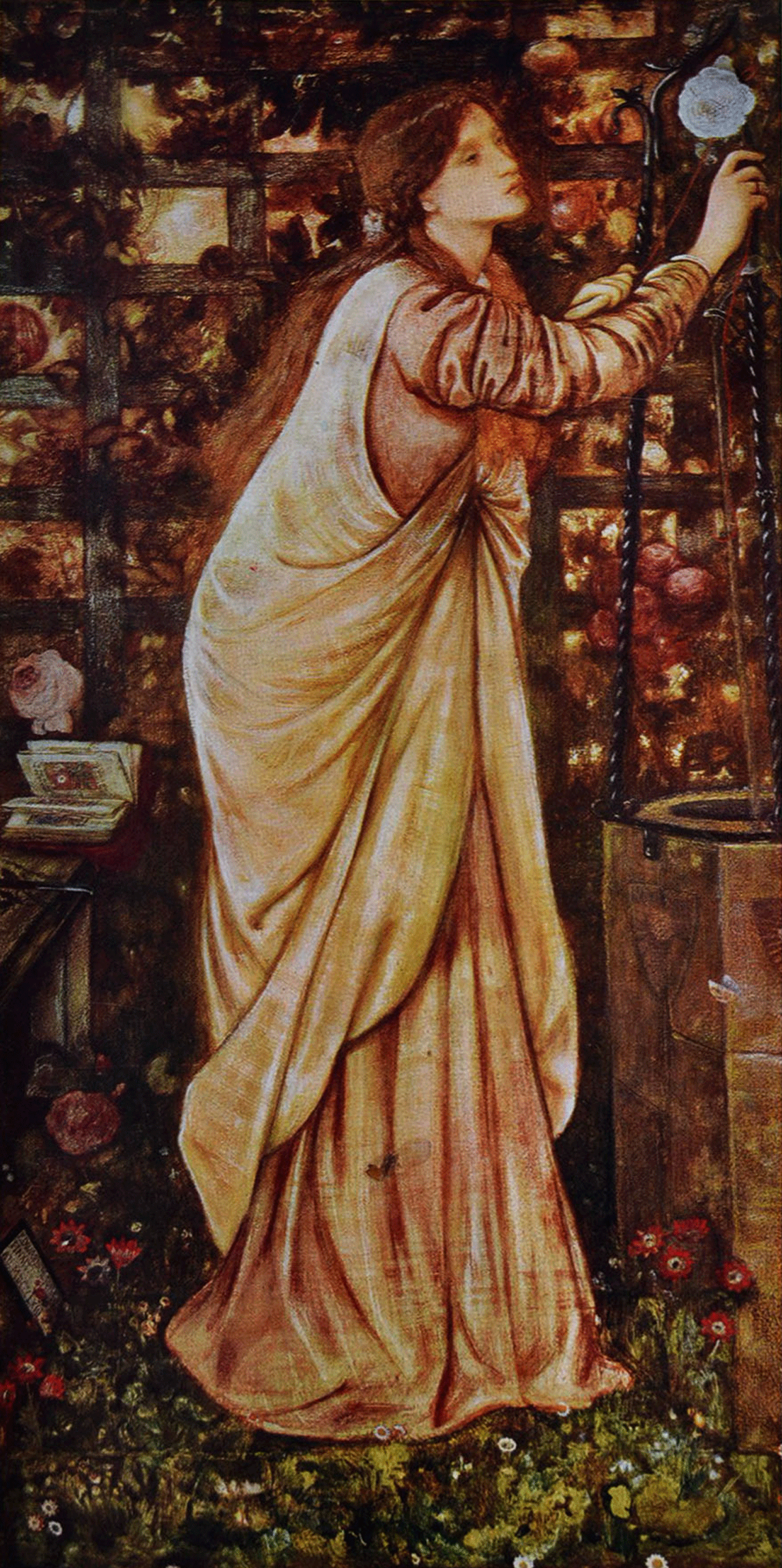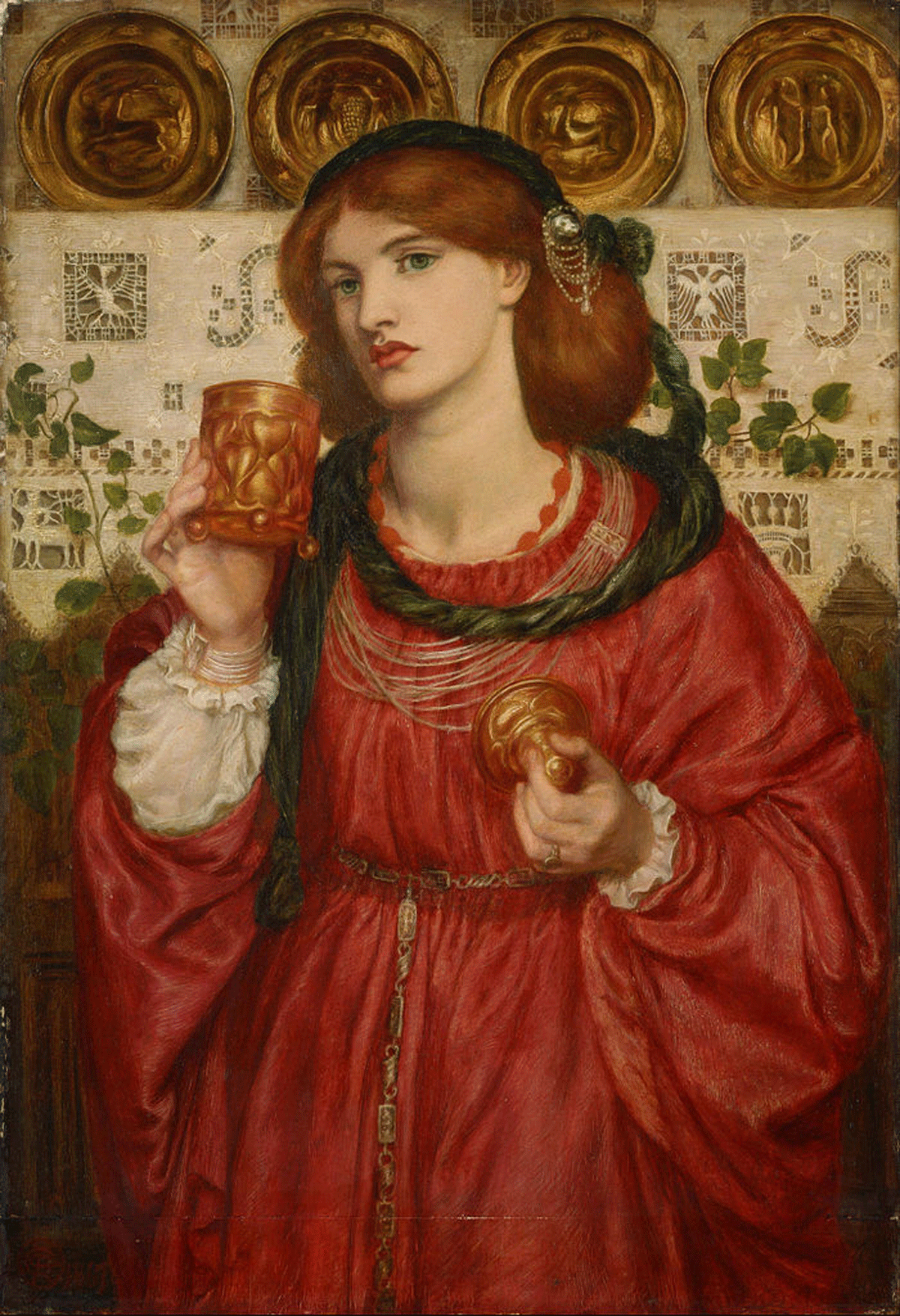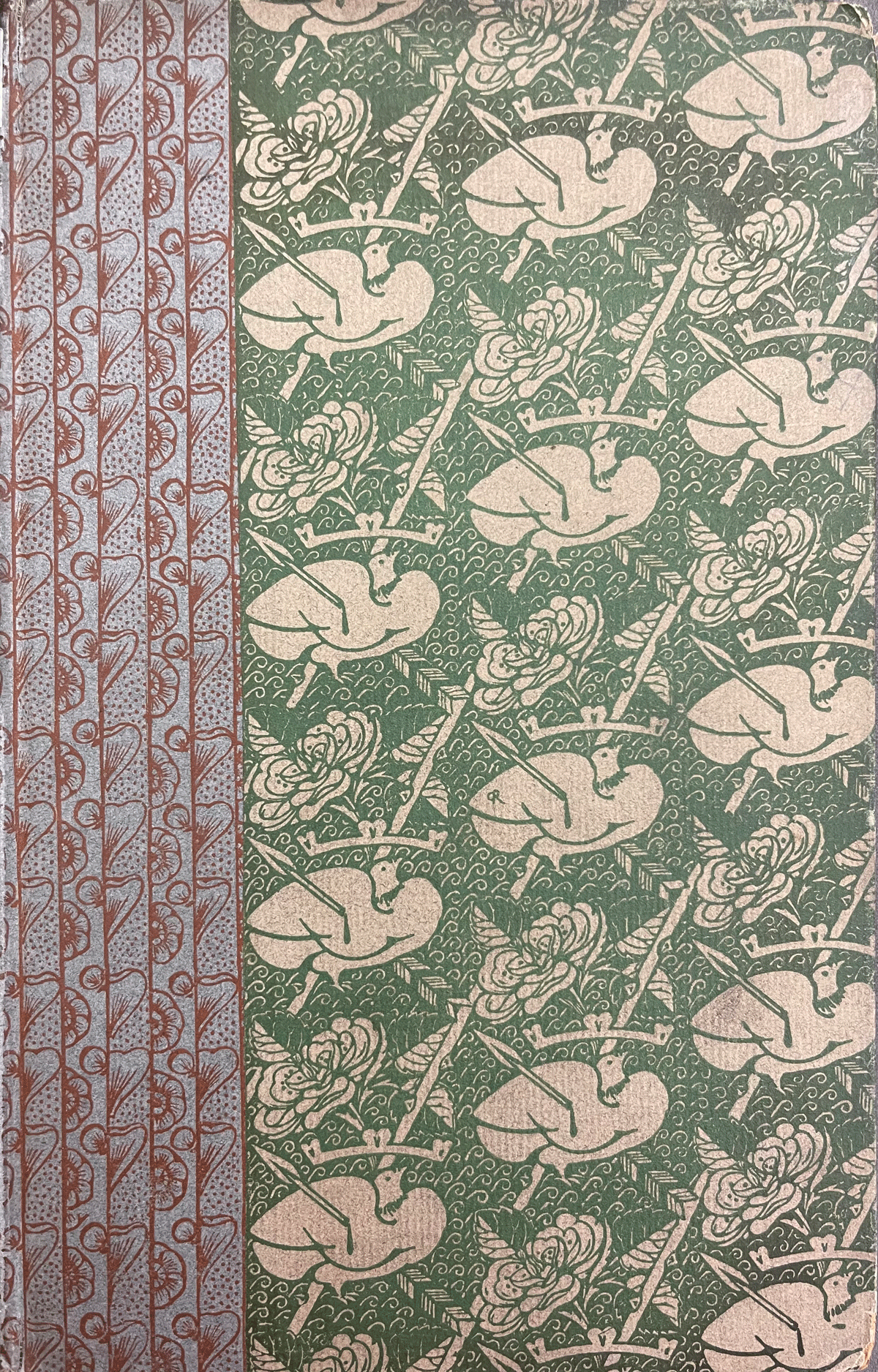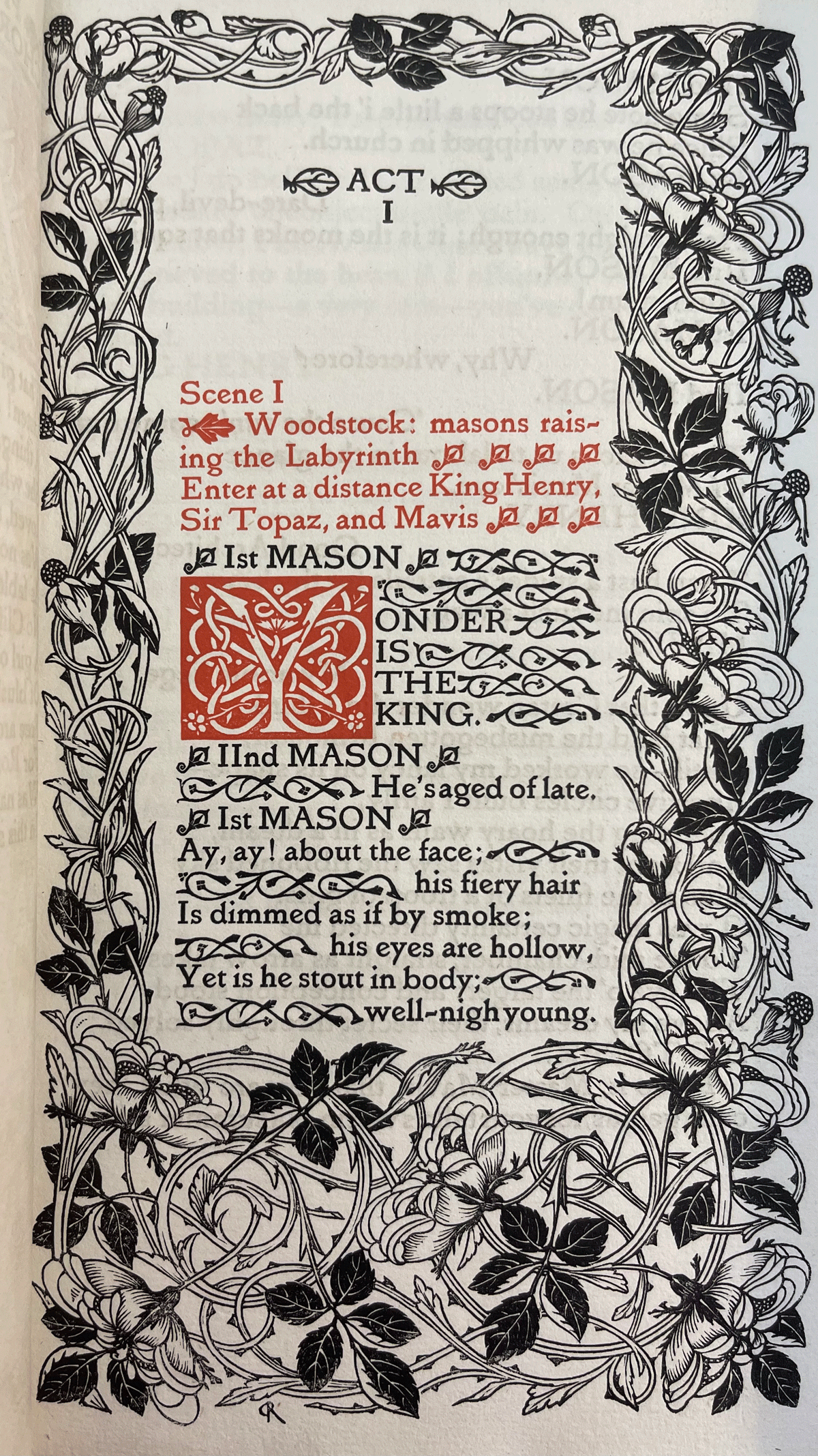It was a fair beginning for Michael Field when in 1884 Robert Browning called their first book of poetry Callirrhoë: Fair Rosamund, two poetic dramas bound together in one volume, the work of ‘genius’ (Fig. 1).1 The dramas, however, did not receive equal praise, and while Callirrhoë received outstanding reviews, critics were less impressed by Fair Rosamund. A. Mary F. Robinson, for example, described it as ‘a far inferior effort’ but she also predicted that the drama contained passages of picturesque imagination with promise for the future.2 For the Athenaeum critic, Fair Rosamund was ‘a much rougher work’ that nonetheless showed ‘conception and genuine poetic vigour of expression’. The reviewer argued that ‘the comparative quiet, however, with which the king is made to accept the murder of his favourite, is, to say the least of it, not impressive’.3 In a similar vein the New York Daily Tribune commented: ‘“Fair Rosamund” has dramatic force, life and reality, but here Mr. Field is still more unfortunate in his subject than in “Callirrhoë”.’4
In Callirrhoë Michael Field dramatized the beginnings of the cult of Dionysus in Greece. It also revealed the poets’ own obsession with the Dionysian, which would become central to their decadent pagan aesthetics at a moment when decadence itself was emerging as a philosophical discourse partly rooted in the cadences of classicism. In notes to the preface, Bradley writes: ‘Does not the Dionysian Theatre reveal the eternal need for the spectacle of g[rea]t emotions?’5 Modern critics have followed critics of the past in highlighting the drama’s outstanding quality. Then and now, critics and readers alike agree that the originality and origins of Michael Field’s decadent poetics reside in this play.6 The Michael Field poets never published anything without any philosophical or poetical reason, and just as the drama’s plot centred on the rise of the worship of Dionysus in Greece, the play marked a similar birth: that of the Dionysian playwright Michael Field.
And yet, as I have explored elsewhere, the book’s cover astutely signalled two joined aesthetics. While the marble-styled binding of the book was deliberately chosen to emphasize its affiliation to classical Greek and Roman sculpture (they would call their books statuettes), its white cover, made of white parchment, hinted too to medieval and Renaissance books, which were bound in white vellum leather, a clear reference to the medievalism of Fair Rosamund, and a material favoured by Pre-Raphaelite and aesthetic print presses.7 In this article I argue that Fair Rosamund voiced another decadence, rooted in Pre-Raphaelitism, which has remained unexplored in studies of Michael Field and, more generally, of the period. Pre-Raphaelitism, with its emphasis on symbolism, gave Michael Field the flexibility of thinking conceptually about poetry not as an art created in isolation, but in direct dialogue with the other arts.
Michael Field selected the legend of the ‘Fair Rosamund’ (Rosa Mundi — Rose of the World — also spelled Rosamond) because Pre-Raphaelite artists and writers were fascinated by the medieval legend, which recounted the love affair of the beautiful Rosamund Clifford and Henry II, king of England, husband of Queen Eleanor of Aquitaine. The legend had the flavour of the Arthurian and the Roman de la rose traditions, but it was grounded in English history, a matter of great importance for British artists and writers too eager to trace accounts of sexual transgressions in their own culture. Due to the lack of accurate details, or perhaps because of it, the affair easily segued into fantasy and storytelling. According to the legend, Henry II created a secret bower at the centre of a labyrinthian rose maze where the lovers met. While the historical Clifford was abandoned by the king and died later of natural causes, the legend shows the queen finding her way through the rose maze to find Rosamund, who was given the choice to die either by poison or with the dagger. The chronicles attest, however, that this would not have been possible, because the king had put the queen in prison. But the tale of beauty, thwarted love, passion, and revenge remained central to Pre-Raphaelite poets and painters, most of whom attacked the idea of marriage as a social contract and were interested in love and desire for their own sake. Rosamund thus became the symbol of radical transgression, her radical beauty the very image of Pre-Raphaelitism.
Tennyson had mentioned the legend of Rosamund as early as 1833 in his poem ‘A Dream of Fair Women’, but the earliest account in Pre-Raphaelite circles was Arthur Hughes’s painting Fair Rosamund (1854). Hughes depicted Rosamund in the garden with a lute and a large tapestry (possibly a wallpaper) portraying two kissing doves as the queen walks towards her. Rosamund is clearly an artist in this representation. But it was arguably Swinburne who really started the Pre-Raphaelite craze for the legend with his verse-drama Rosamond (1860). He sided with the lovers, a view that would dominate most Pre-Raphaelite responses to the tale.8 The core of Swinburne’s drama was a man’s right to love. Having conveniently married Eleanor for power, Henry II finds love with Rosamund. She represents the courtly idea of love and carnal pleasures and incarnates beauty. But his Rosamund is more fundamentally a Pre-Raphaelite artist: a singer and a poet challenging convention.
Dante Gabriel Rossetti’s painting Fair Rosamund (1861) depicts Rosamund as a Pre-Raphaelite beauty with the motifs of the rose and the red cord used by the queen to find Rosamund in the rose labyrinth (Fig. 2). Though ‘framed’ and trapped, the rose bunch in her hand suggests, too, that she is an artist or writer. Emma Sandys’s 1874 painting Fair Rosamund was exhibited at the Society of Women Artists. Her painting sided with Rosamund’s plight as a woman in love. Coinciding with the publication of Michael Field’s Fair Rosamund in 1884, Tennyson placed the story of Rosamund (which he followed somewhat historically) at the heart of his 1884 play Becket. This recounts Henry II’s successful assassination plot to kill the Archbishop of Canterbury, Thomas à Becket, who in the play helps Rosamund by thwarting her assassination by the queen. Ellen Terry would play the role of Rosamund in Tennyson’s drama at the Lyceum Theatre in 1893 (Fig. 3).
Spilling into the twentieth century, are, for example, Evelyn De Morgan’s Queen Eleanor and Fair Rosamund (c. 1901–02) in which the older queen brings poison to an innocent young woman. The painting has many interpretations showing a powerful woman in command of the dark arts while it also asks for sympathy for the radical life, free of social constraints, that the young and unprotected woman represents. John William Waterhouse’s Fair Rosamund (1916) appears to link Rosamund to Tennyson’s poem, ‘The Lady of Shalott’ (1833; 1842). In Waterhouse’s painting, Rosamund also awaits the king. As in all Pre-Raphaelite representations of the legend, Waterhouse’s Rosamund is, too, a Pre-Raphaelite artist: a square tambour with an embroidered tapestry sits next to her, while she is watched by Queen Eleanor.
Michael Field’s inspiration for their 1884 play came from both Swinburne’s poetic drama and Edward Burne-Jones’s paintings on the subject. Since his student days in Oxford, Burne-Jones had been fascinated by the tale, visiting the supposed burial of Rosamund Clifford in Godstow. He would treat the story several times in the 1860s. Katharine Bradley felt ‘delight’ when she saw his Fair Rosamund of 1863 on the walls of Ruskin’s drawing room in Brantwood in 1882.9 The painting depicts Rosamund by a well holding the red thread. Next to her is an illuminated book that connotes she is a poet and artist (Fig. 4).
Michael Field’s Fair Rosamund offered another recreation of the legend. For Pre-Raphaelite women writers and artists, Rosamund posed a major problem. Prior to the Pre-Raphaelites, depictions of the story traditionally referred to her as Rosa inmundi, for she was having an affair outside the bonds of marriage with a married man. Should she, therefore, be represented as an innocent young woman or a fallen one? The legend also has very sinister undertones as a sadistic Bluebeard fantasy, in which a young girl is imprisoned in a ‘golden cage’ to pleasure the king. A further difficulty is that the king replaces a powerful queen, warrior, and enlightened woman with a young and innocent girl, with the climax of the story centring on the queen killing Rosamund. Michael Field, too, sided with free love (or rather with Rosamund), but in the final encounter between Rosamund and the queen, the latter asks, ‘Have you once thought of me these many days? Queen, wife, and mother, and the thing you are’ (p. 199). Overall, Michael Field’s account does not offer a clear-cut affiliation with the courtly love tradition but instead exposes in parallel its dark side, particularly for women of different races and classes. This explains why critics found its ending too unsatisfactory.
The verse-drama starts with the very building of the rose maze, which they gave the shape of a rose. Rosamund is an orphaned country girl of gentle origins, living with her stepfather and stepsister, for whom she cares and loves very much. She is honourable and respectable; in fact, the lovers (much like Bradley and Cooper themselves) think of themselves as married. She is aware that she is put in a ‘prison’ of some sort by the king but her unsuccessful attempts at leaving make her (and us) realize how powerless she is. She finally accepts living in the palace built for her because, as they make her see, her love cures the king’s soul. While the king is away, she is taught by Sir Topaz (the king’s friend and her warden — or, more accurately, jailer) the art of singing and playing the lute. We see her at the end of the play mastering those arts, as well as poetry. Perhaps the play is, indirectly, a comment about the domestic situation of Katharine Bradley and Edith Cooper, whose parents wanted to keep Bradley (her aunt) from their daughter. During this early period the women plotted visits to museums to be alone against the wishes of Cooper’s parents. Rosamund learns her art away from her stepfamily.
A key character in the story introduced by Michael Field is Margery, Rosamund’s stepsister, an innocent dark-skinned girl who spends her time with the fairies. Through her we see Michael Field’s take on the courtly love tradition. Margery’s innocence makes her the prey of Wilfred, a knight, and the real villain of the story. He defiles Margery and leaves her with a witch so that he may use her to bring down the king and Rosamund. He ‘poisons’ Queen Elinor (Michael Field’s spelling) with the tale of the lovers, adorning the story to provoke her into murder. The queen herself is portrayed as a snake, dangerous and bloodthirsty. She has raised their children as warlords, instilling in them a deep hatred for each other. Their play presents Rosamund as a woman of a lower class unaware that she is the target of those in power, who ultimately destroy her and her family. Michael Field demands our sympathy for Rosamund, who dares to live and dies for the sake of love. She is ultimately a victim.
The confrontation between the queen and Rosamund suggests that courtly love places women as enemies while men remain free. We learn that Wilfred beats the dark-skinned Margery, and when she realizes that her stepsister, the fair Rosamund, is Wilfred’s real object of desire and that he is simply using her to harm Rosamund, Margery stabs him with the same knife the queen has used to kill Rosamund. As he lays bleeding, Wilfred tells the king: ‘We have had our pleasure the forbidden way, | Each after his own fashion’ (p. 203). With this play, Michael Field thus presented their cards as a Pre-Raphaelite poet that challenged preconceived assumptions about love, gender, race, and desire.
Throughout their career, Michael Field always aspired to the Pre-Raphaelite dialogue between poetry and the arts and, from this play onwards, particularly during the later 1880s and 1890s, the poets would continue to use Pre-Raphaelitism to produce decadent verse-dramas, often combining different art forms. If Swinburne had been their model for their first Pre-Raphaelite poetic drama, Rossetti would be the inspiration for later plays. Their play The Cup of Water (1887) recreated Rossetti’s painting The Loving Cup (Fig. 5) as well as his prose story The Cup of Water (published just a year earlier in 1886). A study of the theoretical dialogue between the two art forms was their Sight and Song (1892), which was indebted too to Rossetti’s Sonnets for Pictures (1850).
But if Michael Field’s beginnings in poetry were fair and much lauded by poets and critics alike, the 1890s marked a turn in the reception of their books, with their work receiving increasingly bad reviews, poor sales, and harsh critiques. This was partly because the dual female authorship became widely known. The situation forced the poets to experiment and find new ways of reigniting their career. In 1894 their fortunes changed when Bradley and Cooper met the painters Charles Ricketts and Charles Shannon through a common friend, the painter William Rothenstein. Rothenstein, who had met the poets at the Rossetti exhibition at the New Gallery on New Year’s Day 1894, took them to the Vale, Ricketts and Shannon’s house in Chelsea. A follower of the Pre-Raphaelites, Ricketts was then setting up the Vale Press, an important venture furthering the ideals of the printing revival led by William Morris’s Kelmscott Press (founded in 1891). The couples hit it off and began to refer to themselves as ‘poets and painters’.
In his first letter to the poets, Ricketts invited Michael Field ‘to think of us for your next beautiful tragedy’.10 The poets imagined a new rebirth in a reprint of Fair Rosamund ‘scattered over with roses’. Cooper writes thus in their diary:
We are assailed to grant the new publishers a reprint of Fair Rosamund, scattered over with roses. We must stand to our old works if we are to stand: we have many ‘very bitter enemies’ & to face them with our whole career is the strongest policy. We ask — ‘why we have so many enemies?’ We make out that the nom-de-plume was a cause of enmity, the way it was kept, the way it became known, the way it was unacknowledged & acknowledged. ‘One lady in literature is manageable enough — but two!!’11
Their nom de plume may have been the cause of the press attacks, but not their work. Indeed, the play remained mostly unchanged in the Vale Press edition, but this second Fair Rosamund made possible what had been from the start the core of Michael Field’s Pre-Raphaelite aesthetics: for their poetry to be communicated through, and in dialogue with, the other arts. Cooper writes:
Our boy-driver cuts us boughs of cherry blossoms & and shelter cosily in our Victoria & dream of Rosamund. In 1884 we should certainly have felt interest could we have known of this reprint ‘under the supervision’ of a fair artist, in fashion like unto a Christ of Flanders. And the cover! With what wonder we should have turned from the awkward vegetable parchment of our first volume to this cover of today that bears witness to be associated with the newest crest-wave of modern art.12
Ricketts’s binding combined the rose maze of the book’s spine with the image of the dove and the rose (both representing Rosamund, Fig. 6). Inside, the play itself was at the heart a rose maze, their writing symbolizing the Fair Rosamund (Fig. 7). As in most collaborations, Michael Field and Charles Ricketts would often agree and disagree with each other’s aesthetics, but poets and painter would continue to work in partnership until the poets’ deaths (Edith Cooper died in 1913 and Katharine Bradley in 1914). Indeed, if, in 1884, Fair Rosamund announced Michael Field as a Pre-Raphaelite poet, its republication in 1897 under the auspices of the Vale Press inaugurated another fair beginning for the modern poet Michael Field.
Notes
- This article is dedicated to Hilary Fraser. Michael Field, Callirrhoë: Fair Rosamund (London: Bell, 1884); Letter from Robert Browning to Edith Cooper (28 May 1884), in Michael Field, The Poet: Published and Manuscript Materials, ed. by Marion Thain and Ana Parejo Vadillo (Peterborough, ON: Broadview, 2009), p. 309. [^]
- A. Mary F. Robinson, review of Michael Field, Callirrhoë: Fair Rosamunds, Academy, 7 June 1884, pp. 395–96 (p. 396). [^]
- [Anon.], review of Michael Field, Callirrhoë: Fair Rosamund, Athenaeum, 5 July 1884, pp. 24–25 (p. 25). [^]
- [Anon.], review of Michael Field, Callirrhoë: Fair Rosamund, New York Daily Tribune, 14 December 1884, p. 4. [^]
- Michael Field, Callirrhoë and Fair Rosamund annotated by Michael Field. Oxford, Bodleian Library, MS Poet.e.70, fol. 2. [^]
- See, for example, Yopie Prins, ‘Greek Maenads, Victorian Spinsters’, in Victorian Sexual Dissidence, ed. by Richard Dellamora (Chicago: University of Chicago Press, 1999), pp. 43–81; Sharon Bickle, ‘Victorian Maenads: On Michael Field’s Callirrhoë and Being Driven Mad’, Michaelian, 2 (2010), 1–10 <http://www.thelatchkey.org/Field/MF2/bicklearticle.htm> [accessed 9 February 2023]; LeeAnne M. Richardson, The Forms of Michael Field (Basingstoke: Palgrave, 2021), pp. 57–90; or my own ‘Poets of Style: Poetries of Ascetism and Excess’, in The Cambridge Companion to Victorian Women’s Poetry, ed. by Linda K. Hughes (Cambridge: Cambridge University Press, 2019), pp. 230–45. [^]
- Ana Parejo Vadillo, ‘Sculpture, Poetics, Marble Books: Casting Michael Field’, in Michael Field, Decadent Moderns, ed. by Sarah Parker and Ana Parejo Vadillo (Athens: Ohio University Press, 2019), pp. 67–99. [^]
- Algernon Charles Swinburne, The Queen-Mother, Rosamond: Two Plays (London: Montagu Pickering, 1860). [^]
- See ‘Fair Rosamund’, in Burne-Jones Catalogue Raisonné <https://www.eb-j.org/browse-artwork-detail/MjM0Mw==> [accessed 9 February 2023]. Ruskin’s father had bought the painting for him in 1863 for the sum of £52 10s. See Michael Field, The Fowl and the Pussycat: Love Letters of Michael Field, 1876–1909, ed. by Sharon Bickle (Charlottesville: University of Virginia Press, 2008), p. 56. I wish to thank Jill Ehnnen for helping me find this painting. [^]
- Some Letters from Charles Ricketts and Charles Shannon to ‘Michael Field’ (1894–1902), ed. by J. G. Paul Delaney (Edinburgh: Tragara Press, 1979), p. 9. [^]
- Michael Field, ‘Works and Days’ (1896), London, British Library (BL), Add. MS 46785, fol. 23v. [^]
- Michael Field, ‘Works and Days’ (1897), BL, Add. MS 46786, fol. 38r. [^]

